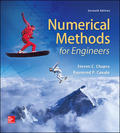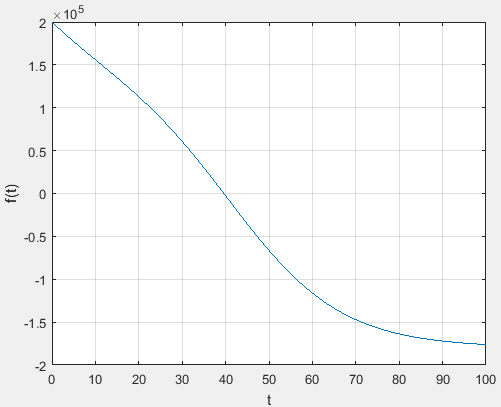
Concept explainers
Many fields of engineering require accurate population estimates. For example, transportation engineers might find it necessary to determine separately the population growth trends of a city and adjacent suburb. The population of the urban area is declining with time according to
while the suburban population is growing, as in
where
(a)
To calculate: The values of the urban and sub-urban population and the corresponding time where the urban population is given by the formula
Answer to Problem 23P
Solution: After 40 years, the suburban population would be 1.2 times the urban population with the populations of the suburban and urban areas being 137482 and 112487, respectively.
Explanation of Solution
Given Information:
The expression,
for the parameters
Calculation:
Substitute 75000 for
Substitute 300000 for
It has been provided that at time t, the suburban population is 20% larger than the urban population, that is, 1.2 times the urban population. Thus, from equation (1) and equation (2),
This equation can be rewritten in the form of a following function whose zero corresponds with the root of the equation,
The desired value of t can be found by plotting the function f with respect to t and then computing the value at which the function crosses the x-axis.
Use the following MATLAB code to plot the function
Execute the above code to obtain the plot as,

From the graph, the curve crosses horizontal axis through the origin at approximately
Substitute 40 for t in the formula for the urban population to get,
Hence, the urban population after 40 years is 112397.
Substitute 40 for t in the formula for the suburban population to get,
Hence, the suburban population after 40 years is 137482.
(b)
To calculate: The values of the urban and sub-urban population and the time where the urban population is given by the formula
Answer to Problem 23P
Solution: After 39.6068 years, the suburban population would be 1.2 times the urban population with the populations of the suburban and urban areas being 13 5142.5 and 112 618.7, respectively.
Explanation of Solution
Given Information:
The expressions,
Formula used:
An equation
Step 1- Compute
Step 2- If
Step 3- Proceed with the same procedure till
Calculation:
Substitute 75000 for
Substitute 300000 for
It has been provided that at time t, the suburban population is 20% larger than the urban population or 1.2 times the urban population. Thus,
The above equation can be rewritten in the form of a following function whose zero corresponds with the root of the equation,
The desired value of t can be found using the false position method.
Let the initial interval be
Then,
As
Now proceed with the first iteration as follows,
Further,
As
Now proceed with the second iteration as follows,
The relative approximate percentage error is,
Continue with the same process till the relative approximate percentage error is less that 0.1%.
Use the following MATLAB code to implement false-position method and solve for the roots iteratively as,
Execute the above code to obtain the solutions tabulated as,
The process is stopped at the fifth iteration where the relative approximate percentage error is less than 0.1%. This gives the value of t as 39.6068 years.
Substitute 39.6068 for t in the formula for the urban population to get,
Hence, the urban population after 39.6068 years is
Substitute 39.6068 for t in the formula for the suburban population to get,
Hence, the suburban population after 39.6068 years is
(c)
To calculate: The values of the urban and sub-urban population and the time where the urban population is given by the formula
Answer to Problem 23P
Solution: After 39.6068 years, the suburban population would be 1.2 times the urban population with the populations of the suburban and urban areas being 13 5142.5 and 112 618.7, respectively.
Explanation of Solution
Given Information:
The expression,
Formula used:
An equation
Step 1: Let
Step 2: Compute
Step 3: Proceed with the same process till
Calculation:
Substitute 75000 for
Substitute 300000 for
It has been provided that at time t, the suburban population is 20% larger than the urban population, that is, 1.2 times the urban population. Thus,
The above equation can be rewritten in the form of a following function whose zero corresponds with the root of the equation.
The desired value of t can be found using the modified secant method.
Let the initial guess be 50 and the value of h be 0.01.
Then,
And,
Now proceed with the first iteration as follows:
Further,
And,
Now proceed with the second iteration as follows:
The relative approximate percentage error is,
Continue with the same process till the relative approximate percentage error is less that 0.1%.
Use the following MATLAB code to implement modified secant method and solve for the roots iteratively as,
Execute the above code to obtain the solutions tabulated as,
The process is stopped at the third iteration where the relative approximate percentage error is less that 0.1%. This gives the value of t as 39.6068 years.
Substitute 39.6068 for t in the formula for the urban population to get,
Hence, the urban population after 39.6068 years is
Substitute 39.6068 for t in the formula for the suburban population to get:
Hence, the suburban population after 39.6068 years is
Want to see more full solutions like this?
Chapter 8 Solutions
EBK NUMERICAL METHODS FOR ENGINEERS
Additional Engineering Textbook Solutions
Elementary & Intermediate Algebra
Calculus for Business, Economics, Life Sciences, and Social Sciences (14th Edition)
APPLIED STAT.IN BUS.+ECONOMICS
Elementary and Intermediate Algebra: Concepts and Applications (7th Edition)
Elementary Algebra For College Students (10th Edition)
Calculus: Early Transcendentals (2nd Edition)
- 5. The figure shows a gear train. There is no friction at the bearings except for the gear tooth forces. The material of the milled gears is steel having a Brinell hardness of 170. The input shaft speed (n2) is 800 rpm. The face width and the contact angle for all gears are 1 in and 20° respectively. In this gear set, the endurance limit (Se) is 15 kpsi and nd (design factor) is 2. (a) Find the revolution speed of gear 5. (b) Determine whether each gear satisfies the design factor of 2.0 for bending fatigue. (c) Determine whether each gear satisfies the design factor of 2.0 for surface fatigue (contact stress). (d) According to the computation results of the questions (b) and (c), explain the possible failure mechanisms for each gear. N4=28 800rpm N₁=43 N5=34 N₂=14 P(diameteral pitch)=8 for all gears Coupled to 2.5hp motorarrow_forward1. The rotating steel shaft is simply supported by bearings at points of B and C, and is driven by a spur gear at D, which has a 6-in pitch diameter. The force F from the drive gear acts at a pressure angle of 20°. The shaft transmits a torque to point A of TA =3000 lbĘ in. The shaft is machined from steel with Sy=60kpsi and Sut=80 kpsi. (1) Draw a shear force diagram and a bending moment diagram by F. According to your analysis, where is the point of interest to evaluate the safety factor among A, B, C, and D? Describe the reason. (Hint: To find F, the torque Tд is generated by the tangential force of F (i.e. Ftangential-Fcos20°) When n=2.5, K=1.8, and K₁ =1.3, determine the diameter of the shaft based on (2) static analysis using DE theory (note that fatigue stress concentration factors need to be used for this question because the loading condition is fatigue) and (3) a fatigue analysis using modified Goodman. Note) A standard diameter is not required for the questions. 10 in Darrow_forward3 N2=28 P(diametral pitch)=8 for all gears Coupled to 25 hp motor N3=34 Full depth spur gears with pressure angle=20° N₂=2000 rpm (1) Compute the circular pitch, the center-to-center distance, and base circle radii. (2) Draw the free body diagram of gear 3 and show all the forces and the torque. (3) In mounting gears, the center-to-center distance was reduced by 0.1 inch. Calculate the new values of center-to-center distance, pressure angle, base circle radii, and pitch circle diameters. (4)What is the new tangential and radial forces for gear 3? (5) Under the new center to center distance, is the contact ratio (mc) increasing or decreasing?arrow_forward
- 2. A flat belt drive consists of two 4-ft diameter cast-iron pulleys spaced 16 ft apart. A power of 60 hp is transmitted by a pulley whose speed is 380 rev/min. Use a service factor (Ks) pf 1.1 and a design factor 1.0. The width of the polyamide A-3 belt is 6 in. Use CD=1. Answer the following questions. (1) What is the total length of the belt according to the given geometry? (2) Find the centrifugal force (Fc) applied to the belt. (3) What is the transmitted torque through the pulley system given 60hp? (4) Using the allowable tension, find the force (F₁) on the tight side. What is the tension at the loose side (F2) and the initial tension (F.)? (5) Using the forces, estimate the developed friction coefficient (f) (6) Based on the forces and the given rotational speed, rate the pulley set. In other words, what is the horse power that can be transmitted by the pulley system? (7) To reduce the applied tension on the tight side, the friction coefficient is increased to 0.75. Find out the…arrow_forwardThe tooth numbers for the gear train illustrated are N₂ = 24, N3 = 18, №4 = 30, №6 = 36, and N₁ = 54. Gear 7 is fixed. If shaft b is turned through 5 revolutions, how many turns will shaft a make? a 5 [6] barrow_forwardCE-112 please solve this problem step by step and give me the correct answerarrow_forward
- CE-112 please solve this problem step by step and give me the correct answerarrow_forwardCE-112 solve this problem step by step and give me the correct answer pleasearrow_forwardPlease do not use any AI tools to solve this question. I need a fully manual, step-by-step solution with clear explanations, as if it were done by a human tutor. No AI-generated responses, please.arrow_forward
- Please do not use any AI tools to solve this question. I need a fully manual, step-by-step solution with clear explanations, as if it were done by a human tutor. No AI-generated responses, please.arrow_forwardCE-112 please solve this problem step by step and give me the correct answerarrow_forwardCE-112 please solve this problem step by step and give me the correct asnwerarrow_forward
 Principles of Heat Transfer (Activate Learning wi...Mechanical EngineeringISBN:9781305387102Author:Kreith, Frank; Manglik, Raj M.Publisher:Cengage Learning
Principles of Heat Transfer (Activate Learning wi...Mechanical EngineeringISBN:9781305387102Author:Kreith, Frank; Manglik, Raj M.Publisher:Cengage Learning International Edition---engineering Mechanics: St...Mechanical EngineeringISBN:9781305501607Author:Andrew Pytel And Jaan KiusalaasPublisher:CENGAGE L
International Edition---engineering Mechanics: St...Mechanical EngineeringISBN:9781305501607Author:Andrew Pytel And Jaan KiusalaasPublisher:CENGAGE L Refrigeration and Air Conditioning Technology (Mi...Mechanical EngineeringISBN:9781305578296Author:John Tomczyk, Eugene Silberstein, Bill Whitman, Bill JohnsonPublisher:Cengage Learning
Refrigeration and Air Conditioning Technology (Mi...Mechanical EngineeringISBN:9781305578296Author:John Tomczyk, Eugene Silberstein, Bill Whitman, Bill JohnsonPublisher:Cengage Learning Automotive Technology: A Systems Approach (MindTa...Mechanical EngineeringISBN:9781133612315Author:Jack Erjavec, Rob ThompsonPublisher:Cengage Learning
Automotive Technology: A Systems Approach (MindTa...Mechanical EngineeringISBN:9781133612315Author:Jack Erjavec, Rob ThompsonPublisher:Cengage Learning Precision Machining Technology (MindTap Course Li...Mechanical EngineeringISBN:9781285444543Author:Peter J. Hoffman, Eric S. Hopewell, Brian JanesPublisher:Cengage Learning
Precision Machining Technology (MindTap Course Li...Mechanical EngineeringISBN:9781285444543Author:Peter J. Hoffman, Eric S. Hopewell, Brian JanesPublisher:Cengage Learning Electrical Transformers and Rotating MachinesMechanical EngineeringISBN:9781305494817Author:Stephen L. HermanPublisher:Cengage Learning
Electrical Transformers and Rotating MachinesMechanical EngineeringISBN:9781305494817Author:Stephen L. HermanPublisher:Cengage Learning





